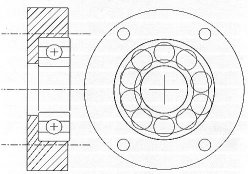
Below are a few methods of fixing the rotating live axle to the chassis.
The axle I recommend for this kart is either 25mm or 30mm of Diameter. So all fixtures are based on this measurement. This axle can be a plain metal bar cut to the correct length with the bearings grubscrewed to the axle. Depending on the hubs you decide upon, these can be keyed/grubscrewed to the axle as well. If you decide upon, the quick, simple and very effective stainless hubs from a wheelbarrow with flat grooved tyres, all you need do is to spot the hub onto the axle, which can be easily ground off at any time. On the wheelbarrow wheels I used, the internal diameter was 25mm, but my axle was turned on a lathe, with my bearings pressed on all requring different diameters. But if it is possible to get access to a lathe, a length of 120mm at both ends could be turned from a 30mm axle down the required diameter. If you don't, you will have to opt for a 25mm axle.
Don't forget that the brakes and sprocket have to be mounted to this axle, so wait before you go rushing in welding things togethor. This section is next in the free plans page. Brake and Sprocket
If you decide upon proper aluminium/plastic hubs, I have plans drawn up for a proper axle hub. Only if you have access to a lathe and the appropiate materials should you set about making hubs. Stick with wheelbarrow hubs, etc with an internal diameter + bush. Plans For Hubs
This first method is the one you should use.
This first method is the most easiest and simplest of them all. I know the diagram looks a bit complicated but all it is, is a housing for a self aligning bearing. The whole unit just bolts onto the chassis on both sides. Easy, simple, quick, less hassle, lasts forever. A grub screw secures the spinning sleeve of the bearing inside the housing to the axle. The little nib you see is for a bit of oil now and again. Some come greese packed requiring no attention ever. The ONLY problem is that they will set you back from between £30 and £50 quid, for an axle of diameter of 30mm. Too dear for the Kart I was building. However you will have to weld a plate to the chassis onto which you can bolt on this bearing, otherwise you would have to drill 4 8mm holes in the chassis, which will destroy the chassis. Take note - NEVER DRILL ANY HOLES IN THE CHASSIS, believe me I learned the hard way, the hole chassis bent out of shape with the middle of the ground nearly hitting off the ground, I had to straighten it all out and weld heavy angle iron to reinforce it.
Scroll down for other methods
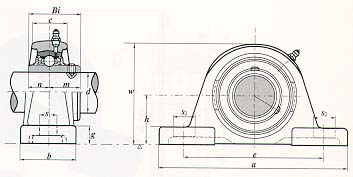
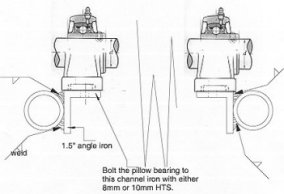

The method I used for my Kart is the following.
This design/method would not be possible for me to make without the very helpful
assistance of a lathe lecturer in a training college. This may well be far
beyond many of your capabilities but take a look. I bought two ordinary plane
roller bearings for £8 each. I then got a housing turned out to house them (see
fig below), and into which the bearings were pressed, and in turn the whole unit
was pressed onto the rear axle. There were four holes in each of the housings
onto which I could bolt onto a plate which was in turn welded to the chassis as
shown (weld symbol left). 
As you can see from the section the bearing was simply pressed into the housing.
See also the four mounting holes.
You can also see the setup I have at the moment, including everything except for the hubs, the wheelbarrow wheels are just spotted to the axle. Whatever bearings method you decide to use you will either have to take down the ends of a 30mm axle on a lathe, or opt for a slightly weaker 25mm axle. You will also see that a 8mm steel plate is welded to the chassis, onto which the bearings can be bolted onto. This aids easy removal, without weakening the axle. Forget about the machined hubs unless you know someone with a lathe. I you are using a 30mm axle, I suggest that about 125mm should be taken down at both ends. The brakes and sprocket mountings will be discussed later, so weld nothing permanently, to axle or to chassis.
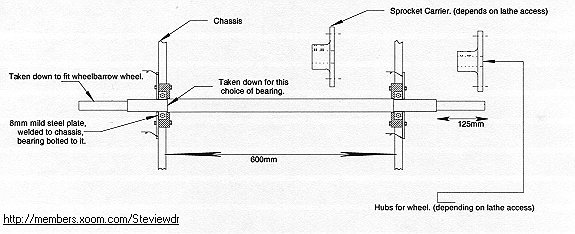
Another crude and very cheap method is to use a VERY simple bushing arrangement on the axle.
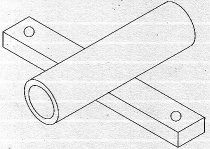 This I do not recommend but I had no choice when
I was starting out, but to use it. All it is, is a pipe welded to a flat bar
bolted to the chassis in which the axle could spin.This needs constant greeseing, and WILL WEAR AWAY, through time. If the
engine you have will drive you over 30mph DO NOT use this method. Both the axle
and the pipe will wear away. Even if a brass sleeve were slotted into this pipe,
first, it still would wear. It is just held onto the axle by split pins and
washers which nessitates the drilling of a hole in the axle !!.(very
worrying!!). This is to allow easy removal for greesing. The pipe should be at
least 150-200mm long.
This I do not recommend but I had no choice when
I was starting out, but to use it. All it is, is a pipe welded to a flat bar
bolted to the chassis in which the axle could spin.This needs constant greeseing, and WILL WEAR AWAY, through time. If the
engine you have will drive you over 30mph DO NOT use this method. Both the axle
and the pipe will wear away. Even if a brass sleeve were slotted into this pipe,
first, it still would wear. It is just held onto the axle by split pins and
washers which nessitates the drilling of a hole in the axle !!.(very
worrying!!). This is to allow easy removal for greesing. The pipe should be at
least 150-200mm long.